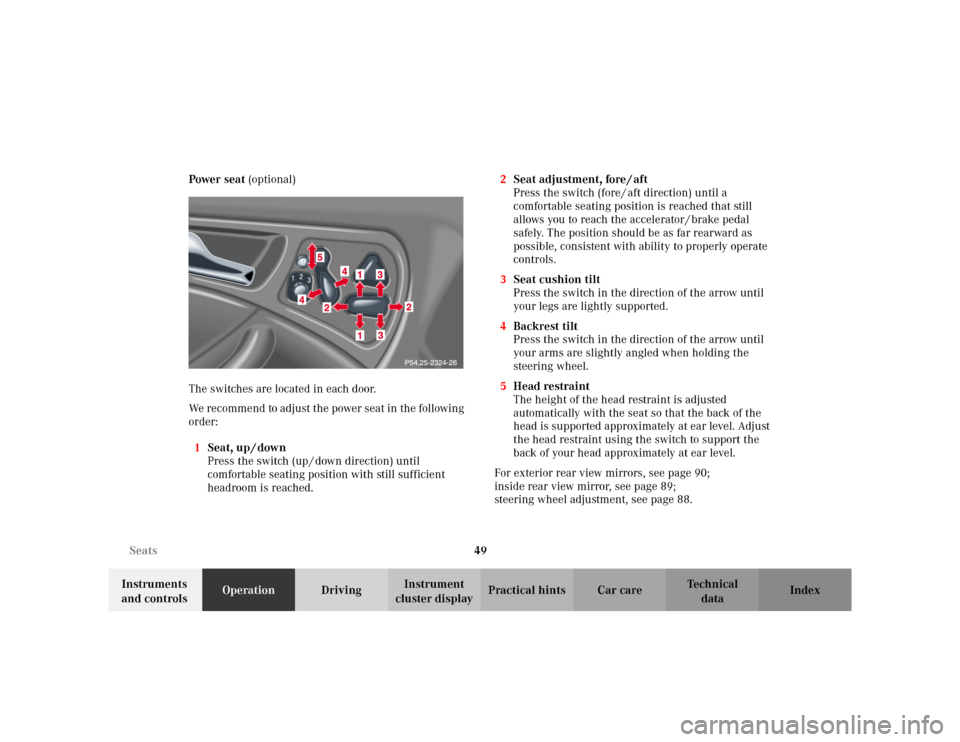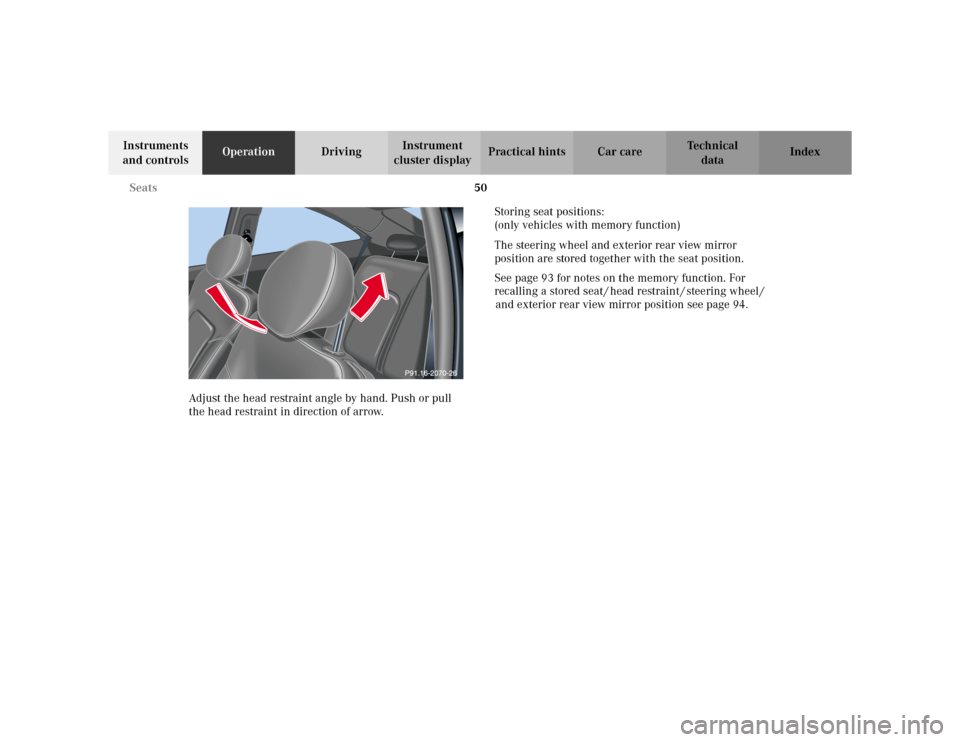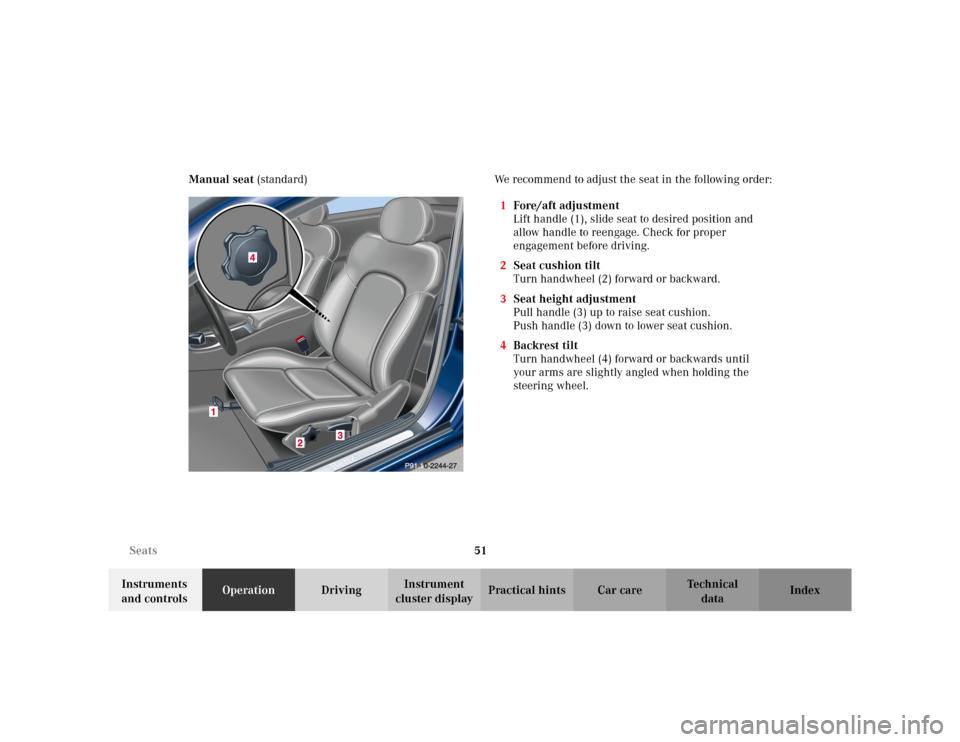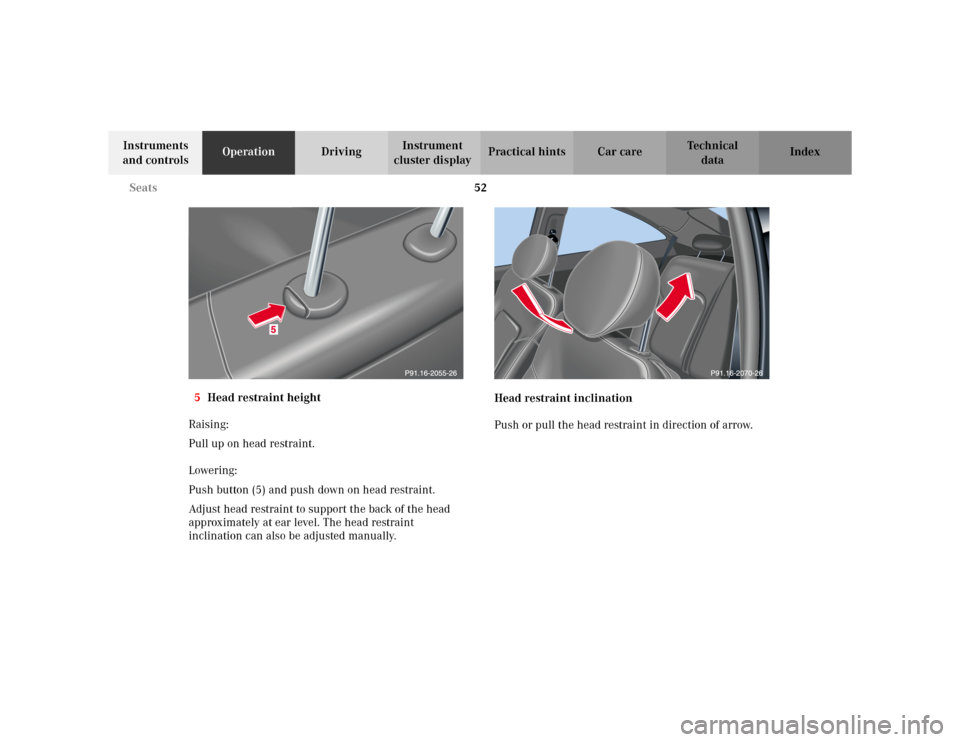2002 MERCEDES-BENZ C230 KOMPRESSOR COUPE seats
[x] Cancel search: seatsPage 4 of 399

1 Contents
IntroductionProduct information .......................... 7
Operator’s manual ............................. 8
Where to find it ................................ 13
Reporting Safety Defects ................ 15Instruments and controlsInstruments and controls ............... 18
Door control panel ....................... 20
Overhead control panel ............... 21
Dashboard ..................................... 22
Center console .............................. 24OperationVehicle keys ...................................... 28
Start lock-out..................................... 30
General notes on the
central locking system ............... 30
Central locking system ................... 31
Radio frequency and
infrared remote control ............... 31
Locking and unlocking ................ 33Choosing global or selective
mode on remote control.............. 33
Opening and closing windows
and sliding / pop-up roof
from outside ................................. 34
Panic button ................................. 35
Mechanical keys .......................... 35
Doors ................................................. 36
Central locking switch.................... 38
Automatic central locking.............. 40
Emergency unlocking
in case of accident ...................... 40
Trunk.................................................. 41
Trunk lid emergency release ....... 43
Antitheft alarm system................... 44
Tow-away alarm ............................... 46
Easy-entry/exit feature .................. 47
Front seat adjustment..................... 48
Removal and installation of
front seat head restraints .......... 54
Front seat backrest
- locking and unlocking ............. 56
Heated seats ..................................... 58
Rear seat head restraints ............... 60Seat belts and integrated
restraint system .......................... 62
Seat belts ........................................... 62
Seat belt nonusage
warning system ........................... 63
BabySmart
TM airbag
deactivation system .................... 69
Self-test BabySmart
TM without
special child seat installed ........ 69
Supplemental Restraint
System (SRS)................................ 70
Emergency tensioning
retractor (ETR)............................. 71
Airbags .............................................. 72
Safety guidelines for the seat
belt, emergency tensioning
retractor and airbag.................... 80
Infant and child
restraint systems......................... 82
Steering wheel adjustment
(manual) ....................................... 87
Steering wheel adjustment
(electrical) .................................... 88
Rear view mirrors ............................ 89
Instrument cluster ........................... 96
Page 29 of 399

26 Contents - Operation
Te ch n i c a l
data Instruments
and controlsOperationDrivingInstrument
cluster displayPractical hints Car care Index
OperationVehicle keys ...................................... 28
Start lock-out..................................... 30
General notes on the
central locking system ............... 30
Central locking system ................... 31
Radio frequency and
infrared remote control ............... 31
Locking and unlocking ................ 33
Choosing global or selective
mode on remote control .............. 33
Opening and closing windows
and sliding / pop-up roof
from outside .................................. 34
Panic button .................................. 35
Mechanical keys ........................... 35
Doors .................................................. 36
Central locking switch .................... 38
Automatic central locking .............. 40
Emergency unlocking
in case of accident ...................... 40
Trunk ................................................. 41
Trunk lid emergency release ........ 43
Antitheft alarm system ................... 44Tow-away alarm ............................... 46
Easy-entry/exit feature .................. 47
Front seat adjustment..................... 48
Removal and installation of
front seat head restraints .......... 54
Front seat backrest
- locking and unlocking ............. 56
Heated seats ..................................... 58
Rear seat head restraints ............... 60
Seat belts and integrated
restraint system .......................... 62
Seat belts .......................................... 62
Seat belt nonusage
warning system........................... 63
BabySmart
TM airbag
deactivation system.................... 69
Self-test BabySmart
TM without
special child seat installed ........ 69
Supplemental Restraint
System (SRS) ............................... 70
Emergency tensioning
retractor (ETR) ............................. 71
Airbags.............................................. 72Safety guidelines for the seat
belt, emergency tensioning
retractor and airbag.................... 80
Infant and child
restraint systems......................... 82
Steering wheel adjustment
(manual) ....................................... 87
Steering wheel adjustment
(electrical) .................................... 88
Rear view mirrors ............................ 89
Instrument cluster ........................... 96
Multifunction steering wheel,
multifunction display ............... 102
Trip and main odometer and
sub menu ................................... 106
Audio systems ................................ 108
Radio ............................................ 108
CD player ..................................... 109
Cassette player ........................... 110
Telephone ......................................... 111
Navigation system........................... 116
Trip computer ................................. 117
Malfunction/warning
message memory ....................... 119
Page 51 of 399

48 Seats
Te ch n i c a l
data Instruments
and controlsOperationDrivingInstrument
cluster displayPractical hints Car care Index
Front seat adjustment
To operate the front power seat adjustment switches,
turn the electronic key in starter switch to position 1
or 2 (with respective door open, the power seats can
also be operated with the electronic key removed or in
starter switch position 0).
Wa r n i n g !
Do not adjust the driver’s seat while driving.
Adjusting the seat while driving could cause the
driver to lose control of the vehicle.Never ride in a moving vehicle with the seat back
reclined. Sitting in an excessively reclined position
can be dangerous. You could slide under the seat
belt in a collision. If you slide under it, the belt
would apply force at the abdomen or neck. That
could cause serious or fatal injuries. The seat back
and seat belts provide the best restraint when the
wearer is in an upright position and belts are
properly positioned on the body.Never place hands under seat or near any moving
parts while a seat is being adjusted.
When leaving the vehicle always remove the
electronic key from the starter switch, and lock
your vehicle. The power seats can also be operated with the
driver’s or front passenger door open. Do not leave
children unattended in the vehicle, or with access
to an unlocked vehicle. Unsupervised use of vehicle
equipment may cause serious personal injury.
Page 52 of 399

49 Seats
Te ch n i c a l
data Instruments
and controlsOperationDrivingInstrument
cluster displayPractical hints Car care Index Power seat (optional)
The switches are located in each door.
We recommend to adjust the power seat in the following
order:
1Seat, up / down
Press the switch (up / down direction) until
comfortable seating position with still sufficient
headroom is reached.2Seat adjustment, fore / aft
Press the switch (fore / aft direction) until a
comfortable seating position is reached that still
allows you to reach the accelerator / brake pedal
safely. The position should be as far rearward as
possible, consistent with ability to properly operate
controls.
3Seat cushion tilt
Press the switch in the direction of the arrow until
your legs are lightly supported.
4Backrest tilt
Press the switch in the direction of the arrow until
your arms are slightly angled when holding the
steering wheel.
5Head restraint
The height of the head restraint is adjusted
automatically with the seat so that the back of the
head is supported approximately at ear level. Adjust
the head restraint using the switch to support the
back of your head approximately at ear level.
For exterior rear view mirrors, see page 90;
inside rear view mirror, see page 89;
steering wheel adjustment, see page 88.
Page 53 of 399

50 Seats
Te ch n i c a l
data Instruments
and controlsOperationDrivingInstrument
cluster displayPractical hints Car care Index
Adjust the head restraint angle by hand. Push or pull
the head restraint in direction of arrow.Storing seat positions:
(only vehicles with memory function)
The steering wheel and exterior rear view mirror
position are stored together with the seat position.
See page 93 for notes on the memory function. For
recalling a stored seat / head restraint / steering wheel /
and exterior rear view mirror position see page 94.
Page 54 of 399

51 Seats
Te ch n i c a l
data Instruments
and controlsOperationDrivingInstrument
cluster displayPractical hints Car care Index Manual seat (standard) We recommend to adjust the seat in the following order:
1Fore/aft adjustment
Lift handle (1), slide seat to desired position and
allow handle to reengage. Check for proper
engagement before driving.
2Seat cushion tilt
Turn handwheel (2) forward or backward.
3Seat height adjustment
Pull handle (3) up to raise seat cushion.
Push handle (3) down to lower seat cushion.
4Backrest tilt
Turn handwheel (4) forward or backwards until
your arms are slightly angled when holding the
steering wheel.
Page 55 of 399

52 Seats
Te ch n i c a l
data Instruments
and controlsOperationDrivingInstrument
cluster displayPractical hints Car care Index
5Head restraint height
Raising:
Pull up on head restraint.
Lowering:
Push button (5) and push down on head restraint.
Adjust head restraint to support the back of the head
approximately at ear level. The head restraint
inclination can also be adjusted manually.Head restraint inclination
Push or pull the head restraint in direction of arrow.
Page 56 of 399

53 Seats
Te ch n i c a l
data Instruments
and controlsOperationDrivingInstrument
cluster displayPractical hints Car care Index Important!
Prior to operating the vehicle, the driver should adjust
the seat height for proper vision as well as fore/aft
placement and backrest angle to insure adequate
control, reach, operation, and comfort. The head
restraint should also be adjusted for proper height. See
also airbag section on page 72 for proper seat
positioning.
In addition, also adjust the steering wheel to ensure
adequate control, reach, operation, and comfort.
Both the inside and outside rear view mirrors should be
adjusted for adequate rearward vision.
Fasten seat belts. Infants and small children should be
seated in a properly secured restraint system that
complies with U.S. Federal Motor Vehicle Safety
Standard 213 and Canadian Motor Vehicle Safety
Standard 213.
All seat, head restraint, steering wheel, and rear view
mirror adjustments as well as fastening of seat belts
should be done before the vehicle is put into motion.
Wa r n i n g !
Children 12 years old and under must never ride in
the front seat, except in a Mercedes-Benz
authorized BabySmart
TM compatible child seat,
which operates with the BabySmart
TM system
installed in the vehicle to deactivate the passenger
side front airbag when it is properly installed.
Otherwise they will be struck by the airbag when it
inflates in a crash. If this happens, serious or fatal
injury can result.
According to accident statistics, children are safer
when properly restrained in the rear seating
positions than in the front seating positions.
Infants and small children must ride in back seats
and be seated in an appropriate infant or child
restraint system, which is properly secured with
the vehicle’s seat belt, fully in accordance with the
child seat manufacturer’s instructions.A child’s risk of serious or fatal injuries is
significantly increased if the child restraints are
not properly secured in the vehicle and the child is
not properly secured in the child restraint.